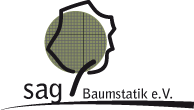Sonic tomography
The propagation velocity of sound travelling through wood depends on the density and the modulus of elasticity of the wood (Rust et al. 2002, Rinn 2003). Certain defects, such as cracks or wet cores, are a not or more difficult penetrable obstacles for sound waves. Where defects are present sound travels to the receiving sensors via a non-direct or non-linear route. Since the path of sound through the wood body is unknown, an “apparent” speed of sound is calculated based on the measured linear distance between the sensors (Rust & Weihs 2007). If the sound travels to the receiving sensor via a detour, a lower apparent sound velocity will result. Therefore, if reduced apparent sound velocities are detected, possible rotting, cavities, or cracks can be inferred.
Since all sensors are included in the sound measurement for each sound pulse created with the hammer, a dense network of sound velocity data is created. The different calculated sound velocities are displayed on the tomogram image using a scale represented with colours.
The density and elastic modulus of intact wood differ between different tree species, and even in trees of the same species, wood density can vary depending on age and environmental conditions (Rinn 2004). For this reason, the highest velocity is used as a reference value for intact wood and the colouring of deviating sound velocities in the tomogram is measured against it. These are therefore relative sound velocities. When interpreting tomograms, therefore, the magnitude of the colour scale must also be taken into account. wood identified as intact will still differ in terms of material properties within species?
In contrast to electrical resistance tomography (ERT), a sonic tomogram (SoT) can be used to provide an assessment of the load-bearing capacity of the tree stem. However, since certain sonic barriers, such as cracks or wet cores, cannot be distinguished from decay on the sonic tomogram, the additional use of ERT electrical resistance tomography can prevent misinterpretation (Clasmeier & Rust 2012).


